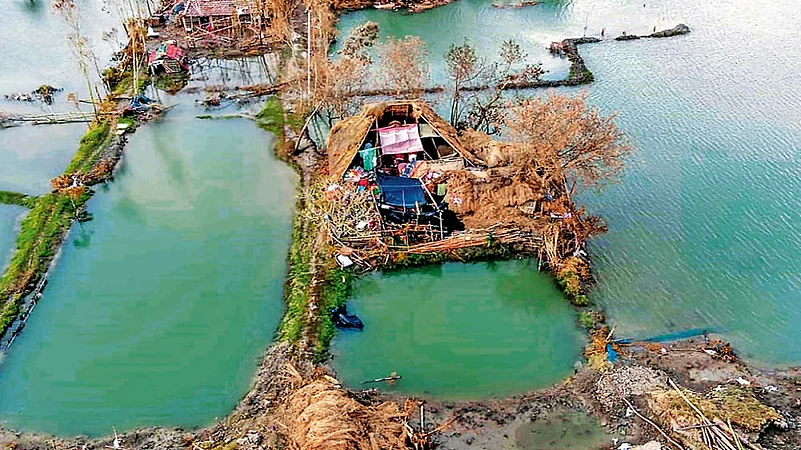Goranbose Gram Bikash Kendra, an NGO working at the grassroots in the Sundarbans region of West Bengal to prevent, rescue and rehabilitate victims of human trafficking, has a separate wing working on climate change. It’s unusual for NGOs engaged in anti-human trafficking activities to focus on issues related to environment. But the two coalesce in the Sundarbans, an ecologically sensitive and densely populated region, prompting the NGO to link cause with effect—the impact of climate change has started affecting livelihood, resulting in migration and human trafficking.
“Climate change has had a direct impact on displacement, local agricultural and fish produce, affecting livelihood, prompting work-related migration and creating a conducive atmosphere for the perpetuation of human trafficking,” says Nihar Ranjan Raptan, who heads Goranbose Gram Bikash Kendra. To effectively design measures to prevent human trafficking, he says, the issue of climate change needs to be addressed first.
Work-related migration has long been associated with human trafficking, as traffickers often lure their hapless targets with the prospect of a better income. Such migration in the Sundarbans started on a huge scale after the devastating cyclone Aila in 2009, which was accompanied by huge storm surges. Even before the extensive damage could be repaired and redressed, the depredations of Cyclone Amphan in 2020—which didn’t even spare Calcutta—wreaked even greater havoc.
Considered one of the climate change hotspots in the world, the Sundarbans is the world’s largest mangrove ecosystem—a delicate filigree made of islands, rivers and creeks, more than half of which lie in Bangladesh. It’s a UNESCO world heritage area and includes a ‘Ramsar site’, indicating a wetland of international importance.
ALSO READ: Farming Takes Body Blow From Climate Change
The eco-system along the Bay of Bengal has, over the past three decades, recorded an alarming rate of rise in sea level and sea-surface temperature, decrease in dew deposition, increasingly erratic weather, including monsoon and post-monsoon weather, and a fast-rising average of the daily minimum temperature.
Together, they all have contributed to the increasing salinity in the waters of the rivers, creeks and even surface water and groundwater—causing a decrease in agricultural and fish production. Fishermen and farmers, the original inhabitants of the land reclaimed about 250 years ago, are migrating to other states for work in their thousands, while their rising desperation makes the Sundarbans one of Bengal’s prime human trafficking hotspots.
ALSO READ: India’s New Edible Oil Plan: What’s Cooking?

“Take the case of the fish Chandana Ilish. It tastes quite similar to the Hilsa. It did not fetch a price as high as Hilsa, but it used to fetch a decent price. Now, over the past few years, the species has vanished from the region. Fishermen do not get them anymore,” says Joykrishna Haldar, president of South Sundarban Fishermen and Fishworkers’ Union and a former MLA from Kultali. Haldar says that among other fishes, Khoyra is available only in small sizes now, which do not fetch a decent enough price in the market.
“Hilsa, Pomfret, Bhola and Mackerel used to be found in abundance even 10-15 years ago, but now the catch has decreased. These are the main cash crops in fishing,” Haldar says, adding that among other fishes, the catch of Amudi, Ruli and Topse, too, have gone down. “As a result, fishing has become a stressful profession to be in. People from traditional fishing families are either changing profession or migrating to the western coast.”
The Indian portion of the Sundarbans is made of 102 islands, of which 54 are inhabited and the rest forested. Sprawled across 19 community development blocks in the districts of South 24-Parganas and North 24-Parganas, it is home to about 4.5 million people, mostly economically stressed and belonging to the backward classes. People here have lived with cyclones, floods, tigers and crocodiles for over two centuries and have adapted to it. But recent changes have distressed these resilient people like never before.
“The sea-level rise is pushing more seawater into the brackish water, increasing the salinity in rivers and creeks. Salinity is increasing even in surface water. A combination of increasing sea-surface temperature and increasing water salinity make traditional pisciculture practices challenging,” says Suman Bhusan Chakraborty, an associate professor of zoology at the University of Calcutta and the principal investigator, fish endocrinology research unit.
ALSO READ: Keep Off The Grass: Don’t Kill Our Grassland
The typically brackish water of the Sundarbans is a mix of sweet and saline water. As the level of salinity increases, species uncomfortable with the change replace their habitat by swimming further upstream in search of less saline water. In some cases, species that have stayed put show changes in reproduction—they are producing fewer offspring.
Chakraborty says that the prospect of farms dealing in freshwater fish was not good. “Chital, Nona Tangra and Telapiya have survived the increased salinity. They have shown tolerance. But the likes of Sarputi have become scarce,” he says.
Pradip Chatterjee, an environmentalist and convener of the National Platform for Small-scale Fishworkers (Inland), says that a similar impact of climate change is apparent on plants and that certain types of mangrove trees are becoming rarer. “Mangroves are considered nurseries for many fish varieties. The roots provide shelter to juvenile fishes from predator fishes and the leaves that drop in the water help the aquatic food chain. The loss of mangroves will certainly affect the abundance of fish,” he observes.
The loss of mangroves, too, is caused by climate change to a certain extent, apart from human intervention in the form of clearing forests. Due to increasing salinity, several mangrove species are finding it difficult to survive. The Sundari tree, from which the entire region gets its name, is itself found rarely now and has long been affected by the ‘top dying disease’—a result of increased salinity.

The destruction left behind by cyclone Aila in 2009.
The fish catch further dwindles in winter, when reduction in the volume of water in the rivers and creeks increases the salinity level. Chatterjee says that this is happening all the more because the rivers that crisscross the region, except the Hooghly, are all fed by tidal water and have no freshwater source.
According to a paper titled Climate Change and Its Collision on Fisheries Resources in Sundarban region of South 24-Parganas, West Bengal, authored by Tanmoy Chatterjee and published in the International Journal of Environment, Science and Technology in 2017, the increase in sea surface temperature may affect several marine fish species and increase the occurrences of intensive tropical cyclone in the Bay of Bengal. “The other scenario found in the Bengal delta is the effect of industrialisation. Greenhouse gases in the atmosphere are causing global climate change and has destroyed huge numbers of fish,” the paper says.
All indications, portents and studies over the past decades have been corroborated in the recently published AR6 report of the Inter-government Committee of Climate Change (IPCC). It noted that the “the most consistent trends are an increase in the occurrence of the most intense TCs (tropical cyclones) and a decrease in the overall TC frequency, in particular in the Bay of Bengal.” This means that the region needs to prepare for more devastating, cyclone-induced storm surges. As for the Sundarbans, the storm surges, which can be as high as 12 metres, have been more dangerous and disastrous than mere inclement cyclonic weather. The storm surges breach embankments and flood hundreds of acres of farmland and freshwater ponds, causing huge agricultural and piscicultural damage.
Chatterjee’s paper suggests adopting proper adaptation techniques to boost the production of inland fisheries. “In coastal areas, soil water salinity and sea level rise have both positive and negative effects. They may increase the area under shrimp, prawn, Hilsa and other fish that flourish in saline water, as well as shell fish—all of which will increase the production of high assessment fish products,” it said.
It is possibly the only silver lining to the dark clouds that announce an environmental disaster of the direst magnitude. The Sundarbans have been sending urgent SOSs to people who wax eloquent about its uniquely mysterious mix of water, forest and majestic wildlife. It is the time to act.
(This appeared in the print edition as "Waves Whisper Closer")
By Snigdhendu Bhattacharya in Calcutta


























